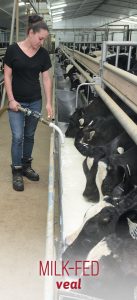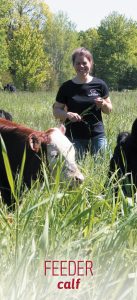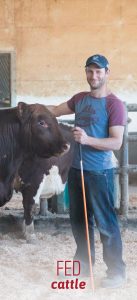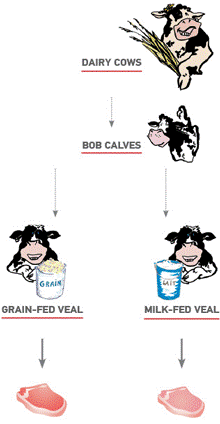At a glance
In the last thirty years, cow and calf production has earned its place as a key livestock sector in Quebec. The quality of the livestock stands out in the markets and the sector is consolidating.
Québec is still a modest player on the Canadian scale, with beef production accounting for around 4% of national production. However, the Québec veal sector is the unchallenged leader in Canada, with about 70% of national production. We should also note that animals culled from the dairy and cow-calf herds contribute to the growth of beef production (so called commercial beef). Québec produces 11% of Canadian commercial beef.
As everywhere else in Canada, the crisis of the bovine spongiform encephalopathy (BSE) and the adverse economic conditions of the late 2000s have certainly led to a decline of the production. However, thanks to its abundant pasture and forage, not to mention the expertise of its producers, Québec has strong development potential.
Beef production ranks fourth in Québec livestock production, after dairy, hog and poultry production. In Québec, there are currently about 8,122 farm operations partially or totally dedicated to cattle production. The producers are men and women with a passion for their profession. Over the years, they have developed modern livestock farming conditions and rigorous quality control, favouring on-farm food safety, animal welfare and animal health.
The agroenvironmental best practices implemented also ensure the sustainable development of cattle farms. Producers care deeply about offering consumers, nutritious, healthy meat of the highest quality!
Present throughout Québec, cattle production is a key pillar of our agriculture and regional development. Over a three-year average, more than 561,928 cattle are marketed each year, with an on-farm value of approximately $695 million.
Two Sectors – 2023 Overview
Québec cattle production encompasses two sectors: beef production and veal production. The beef sector includes feeder calves (cattle fed on pasture), fed cattle, cull cattle and dairy calves. The heavy veal sector includes grain-fed veal calves and milk-fed veal calves.
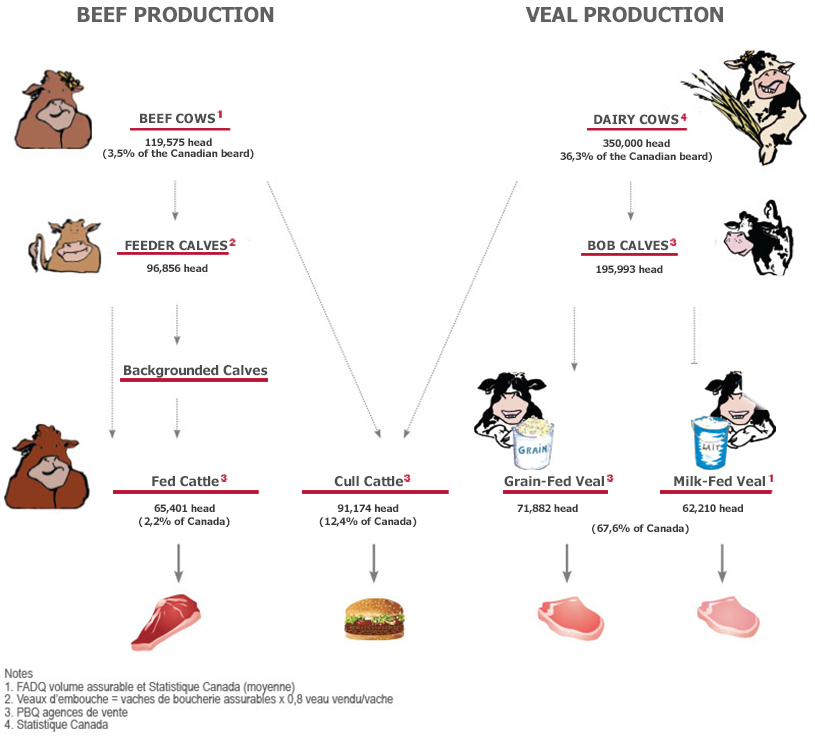
Production At a Glance
Click on a sector to learn more:
Cull Cattle and Bob Calves
Thanks to its sizable dairy and beef sectors, Quebec can rely on a considerable number of cattle to be sold for meat when the time comes for them to be taken out of dairy or veal production.
Cull cattle
Cull cattle make for quality meat, chiefly in the form of ground beef, which is used in fast-food chains and other outlets. These animals generally include dairy cows, beef cows, and bulls.
The lean meat from cull cows is in demand by buyers and the traceability of Quebec cattle is advantageous for the development of new markets.
Why do cattle get culled?
Cattle are culled mostly at the end of their active milk production lives or as veal calves (end of productive period). Milk producers and veal producers must therefore replace their animals with new ones, allowing them to achieve their production targets. This is when cattle are culled, thus being removed from the herd and the farm. The cattle then serve a second purpose, allowing their value to be extracted on the meat market.
The primary function of a dairy cow is to produce milk. At the end of her active life, when she can no longer give enough milk, a dairy cow will find a “second vocation” as a cull cow, generally at the age of five to six years. About 70,000 dairy cows are culled each year in Quebec.
The same scenario applies in the case of beef cattle. While the primary aim of beef cows is to nurse one beef calf (feeder calf) per year, when their time comes to leave (at 7 to 10 years of age on average), beef cows are also sold to abattoirs for meat. Bulls at the end of their active lives are similarly culled. About 20,000 beef cows are culled in the province annually.
By making the decision to cull animals that have reached the end of their useful life and replace them with younger animals, producers are able to renew their herds. Rotating animals in this way also helps improve the genetic makeup of the herd.
Did you know?
- In Québec, 91,174 cull cattle (dairy and beef cattle) produce more than 60 million pounds of beef. Annual sales are about $142 million.
- Quebecers consume an average of 35 lb (16 kg) of ground beef per year.
- The hamburgers at your favourite fast food restaurant chain, the filet mignon at the corner brasserie or the shepherd’s pie at your child’s school cafeteria have one thing in common: they are probably made with meat from Québec cull cattle.
Dairy Calves
Marketed dairy calves are purchased by milk-fed veal or grain-fed veal producers for fattening. Some calves not meeting feedlot requirements may also be slaughtered for meat.
Why sell dairy calves?
Dairy cows must calve so they can lactate and produce milk for consumption. Dairy farmers decide on the use of the resulting calves:
- Keep them in the farm’s herd to become dairy cows when they are females considered fit for milk production;
- Market them to feedlots for fattening as veal calves for most of the males and for females unfit for milk production.
Grain-fed veal
Veal production
In Québec, two types of calves are destined for veal production: grain-fed calves and milk-fed calves. The distinction comes mainly from how the calves are fed, one being fed mostly grain, and the other milk.
It all begins on a dairy farm where the cow, in order to give milk, must also produce calves. After 9 months of gestation, she will give birth to a dairy calf.
The future of the young animal will depend on its sex. If it is a male dairy calf, it will be destined for veal production, while a female (heifer) will become a dairy cow.
Rearing method
Grain-fed calves are raised in an environment that promotes their welfare and development. They are raised in groups and are free to move around as they wish in vast pens. The buildings are designed to provide plenty of space and light.
Grain-fed veal production in Québec also benefits from the ATQ’s cattle traceability program. This program traces the calf from its farm of origin to the slaughterhouse.
Two distinct stages characterize grain-fed veal production: a period in the nursery, followed by a growing period, also called finishing.
Watch the video An encounter with Grain-Fed Veal producer.
Did You Know?
- Quebec has about 126 grain-fed veal producers. The farms are located in several regions of Québec, especially in Montérégie and Centre-du-Québec.
- A typical specialized farm has 807 grain-fed veals per year.
- Production totals 17 882 grain-fed calves yearly, with annual sales come close to $103million (farmgate value).
- Grain-fed veal accounts for about 12% of the volume and 12% value of Québec cattle production.
- Grain-fed veal producers can count on a well established grain-fed veal slaughtering and processing industry. All slaughtering and about 70% of processing are performed in Québec.
- Each $100 million spent in the Quebec veal industry in 2014 generated $49 million in added value for the Quebec economy.
- Employment: the heavy calf sector generates 1,000 jobs.
Milk-Fed Veal
Veal production
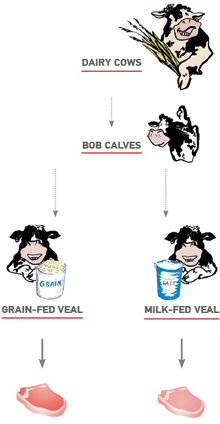 In Québec, two types of calves are destined for veal production: grain-fed calves and milk-fed calves. The distinction comes mainly from how the calves are fed, one being fed mostly grain, and the other milk.
In Québec, two types of calves are destined for veal production: grain-fed calves and milk-fed calves. The distinction comes mainly from how the calves are fed, one being fed mostly grain, and the other milk.
It all starts at the dairy farm, where, to produce milk, the cow must also produce calves. After a nine-month gestation period, the cow delivers a small calf (dairy calf).
The future of the young calf will depend on its gender. Male dairy calves are destined for veal production, whereas female calves (heifers) ultimately become dairy cows.
Raising method
Male dairy calves, generally Holstein, are bought by veal producers who, during the 20-week rearing period, provide optimum conditions: a balanced diet, a healthy environment and personalized care – everything needed to ensure their comfort, good health and growth!
Milk-fed veal production in Québec also benefits from ATQ’s cattle traceability program. This program traces the calf from its farm of origin to the slaughterhouse.
Did you know?
-
- There are about 48 milk-fed veal farms producing approximately 66,210 milk-fed calves per year. The farms are mainly in the Centre-du-Québec and Montérégie regions.
- A typical specialized farm produce 941 milk-fed veal per year.
- The farmgate value is about $120 million.
- Milk-fed veal accounts for approximately 11% of the volume and 14% value of Québec cattle production.
- In 2014, for every $100 million in sales in Quebec’s veal sector, $49 million in added value was injected into the province’s economy.
- Labour: the veal calf sector generates 1,000 jobs
- In its lifetime, a milk-fed calf will drink about 2,000 litres of high-quality milk.
Feeder Calf
Beef production
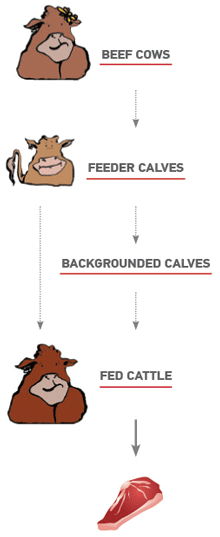
Young calves spend the first months of their lives in the pasture with their dam, a beef cow. At that stage they are called feeder calves (livestock fed on pasture). One year later, feeder calves become fed cattle.
Feeder calves come from beef-breed cattle. Unlike dairy cattle which are raised mainly to produce milk, beef cattle are bred and fed to produce meat. Their distinguishing feature is their genetic potential to produce a larger muscular mass, thus more meat around the bone!
Feeder calves are generally the offspring of cross-breeding. In the first months of their lives, they graze freely on pasture and get milk from their dam.
Traditionally, calves are born between January and April and are sold in autumn. Around the age of 7 to 10 months or a weight of 500 to 800 pounds (225 kg to 360 kg), feeder calves leave the “family nest.” A new life awaits them.
Did you know?
Before beef is served on your plate, about 18 months pass between the birth of a feeder calf and the time it arrives at the slaughterhouse. During those 18 months, generally two, sometimes even three types of producers (cow-calf, occasionally backgrounding operations, and feeders) will be involved in the production process. These producers perform the various feeding and growing operations and ensure the cattle are raised in good conditions.
- Quebec has about 3,100 cattle farms spread throughout Quebec (cow-calf operations).
- A typical specialized farm has 116 cows and produces 94 feeder calves per year.
- 109,349 feeder calves are produced annually in Quebec, for a farmgate value about $200 million.
Feeder calf producers are also often called “cow-calf ” producers.
Fed Cattle
Beef production
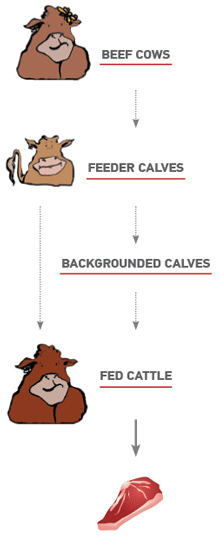 Raising fed cattle begins with the arrival of a feeder calf (calf fed on pasture) in a feedlot. It is typically 7 to 10 months old and weighs 500 to 900 lb (227 to 408 kg).
Raising fed cattle begins with the arrival of a feeder calf (calf fed on pasture) in a feedlot. It is typically 7 to 10 months old and weighs 500 to 900 lb (227 to 408 kg).
Some producers specialize in the “backgrounding” phase, which ends at around 800 to 950 lb (364 to 430 kg). The feeder calves are then ready to begin the “finishing” phase.
The feeder calf will remain in a feedlot for 8 to 10 months, until it reaches a weight of approximately 1475 lbs (670 kg), or 700 to 950 lb carcass weight (318 to 430 kg carcass basis). It is fed primarily grain corn, forage corn, minerals and vitamins.
Cereals (corn, barley) fed to steers increase the tenderness and marbling of the meat. The cattle have continuous access to food and fresh water.
The rations served are balanced, high quality and have high energy content. This diet allows the cattle to gain over 3 lb (1.3 kg) per day. When they reach maturity, fed cattle are sold to the slaughter plant, where they will be processed into many cuts of beef.
Did you know?
In Quebec, about 65,401 fed cattle are produced annually, for a farm value of approximately $215 million.
- A 1,450 lb (658 kg) steer yields an average of 850 lb (385 kg) of meat.
- 200 fed cattle and backgrounding farms are located mainly in the central regions of Quebec.
- The typical specialized farm produces about 2,130 head of fed cattle per year.
 Youtube
Youtube Facebook
Facebook